Cultural depictions of Alfred the Great
Alfred the Great was an Anglo-Saxon King, who ruled Wessex 871 – 899, an Anglo-Saxon kingdom in the south of Great Britain, that existed from 519 — 927. In the late 9th century, the Vikings had overrun most of the Anglo-Saxon kingdoms that constituted England at the time. He was the youngest son of King Æthelwulf of Wessex, his father died when he was young and three of his brothers reigned and died in turn before him. After ascending the throne, Alfred spent several years fighting Viking invasions, until he defeated them at the Battle of Edington in 878, after which under a treaty the Vikings settled towards the east side of England. From this base Alfred's daughter, son and grandson retook lands from the Vikings, until England was unified. Alfred's reign is usually regarded as the first in the lists of English monarchs.
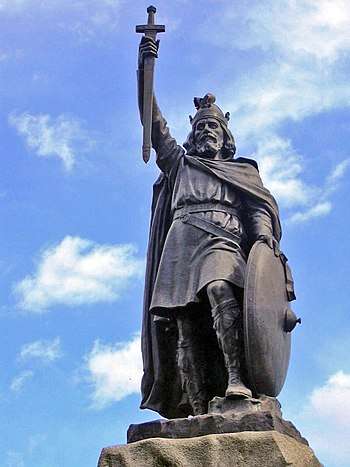
Most of what we know about Alfred comes his biography Life of King Alfred written in 893 by a welsh monk Asser . The manuscript survived to modern times in only one copy, which was part of the Cotton library. Alfred had a reputation as a learned and merciful man of a gracious and level-headed nature who encouraged education, proposing that primary education be conducted in Anglo-Saxon rather than Latin and improving the legal system and military structure and his people's quality of life. During his reign Alfred issued a new law code, gathered scholars to his court and was able to devote funds to building ships, organising an army and establishing a system of local defences.
It was not until the English Reformation in the sixteenth century, that Alfred was given the epithet "the Great" when he was seen as the ideal Christian sovereign. Over 600 years after his life, that Alfred began to inspired many artistic and cultural works from the sixteenth century onwards, with a height in the Victorian Period.
Background to Alfred's growing reputation
Alfred's reign has been regarded as pivotal in the eventual unification of England, after he famously defended Wessex and southern England against the overwhelming Vikings invasions. Apart from his military success, he was also noted for his translations of Latin texts, education reforms (including advocacy of education in the English language rather than in Latin), improving his kingdom's legal system and civic defense. Alfred's positive image may have been accentuated by Bishop Asser, who was commissioned by Alfred to write his biography. Asser presented Alfred 'as the embodiment of the ideal, but practical, Christian ruler'. Later medieval historians William of Malmesbury, Matthew Paris and Geoffrey of Monmouth further reinforced Alfred's favourable image.
However, in the sixteenth century he became a symbolic champion for the emerging English Protestant church during the English Reformation. At this time, over 600 years after his death, he was first given the epithet "the Great". The designation was retained by succeeding generations who admired Alfred's patriotism, success against barbarism, promotion of education, and establishment of the rule of law.[1]
The cult of King Alfred the Great increased until by the reign of Victoria, Alfred was accepted as founder of the nation and an archetypal symbol of the nation's perception of itself. He has been seen as a heroic figure, who centuries after his death inspired many artistic and cultural works. 'Alfredophilia' and 'Alfredomania', found expression in religious, legal, political and historical writing, and in poetry, drama, music, and prose, and in sculpture, painting, engraving, and book-illustration.[2] He is venerated as a saint by some Christian traditions, and is often featured in stained glass windows in Church of England parish churches.[3][4] History has been kind to Alfred, in 2002 he was ranked number 14 in the BBC's poll of the 100 Greatest Britons.[1]
Alfred is often thought to have provided his own epitaph in this passage from his translation of the Consolation of Philosophy by Boethius:
I desired to live worthily as long as I lived, and to leave after my life, to the men who should come after me, the memory of me in good works.
Art and sculpture
There are no surviving images of Alfred from his reign, except on his coins.
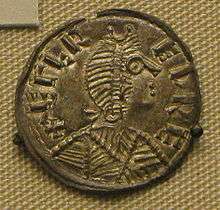 A coin of Alfred, king of Wessex |
Artistic images of King Alfred began to flourish mainly from 18th to the early 20th century.
 13th century depiction of Alfred the Great |
 Alfred in the Isle of Athelney, receiving News of a Victory over the Danes (a 1751 print, after Nicholas Blakey). |
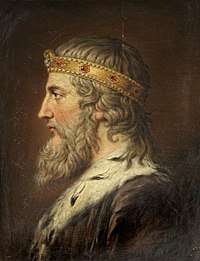 18th century portrait of Alfred by Samuel Woodforde |
_p1.102_ALFRED_THE_GREAT.jpg) Taken from Thomas Mante's Naval and Military History of the Wars of England, including those of Scotland and Ireland, (1800) p1.102 |
King Alfred painted vault over the choir area in St. Mary's Church, Beverley, East Riding of Yorkshire, England. |
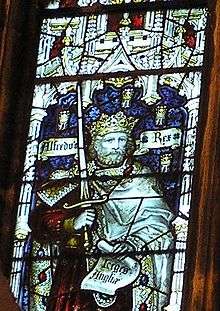 King Alfred the Great pictured in a stained glass window in the West Window of the South Transept of Bristol Cathedral, by Arnold Wathen Robinson |
 Eastern Orthodox Ikon of King St. Alfred the Great |
.jpg) 19th century painting of King Alfred (The Great) |
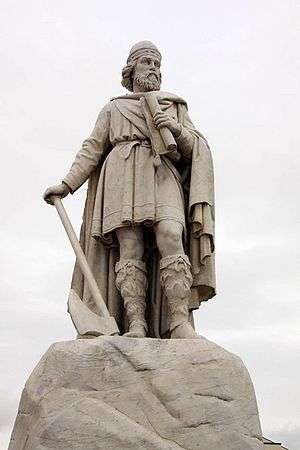 Statue of Alfred the Great at Wantage, Berkshire, 1877. |
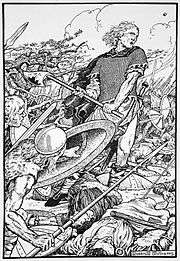 Alfred the Great at the Battle of Ashdown by Morris Meredith Williams (1913) |
.jpg) The Boyhood of Alfred the Great (1913) |
 1904, Alfred the great in the Danish |
Historical writing
Alfred is the subject of several historical works. Early example include:
- Book of Martyrs (1570 edition) by John Foxe
- Life of Alfred by Robert Powell 1634
- Life of King Alfred by Sir John Spelman 1642
Education

A number of educational establishments are named in Alfred's honour:
- The University of Winchester created from the former King Alfred's College, Winchester (1928 to 2004)
- Alfred University and Alfred State College in Alfred, New York; the local telephone exchange for Alfred University is 871 in commemoration of Alfred's ascension to the throne
- The University of Liverpool created a King Alfred Chair of English Literature
- King Alfred's Academy, a secondary school in Wantage, Oxfordshire, the birthplace of Alfred
- King's Lodge School in Chippenham, Wiltshire, so named because King Alfred's hunting lodge is reputed to have stood on or near the site of the school
- The King Alfred School and Specialist Sports Academy, Burnham Road, Highbridge, so named due to its rough proximity to Brent Knoll (a Beacon site) and Athelney
- The King Alfred School in Barnet, North London, UK
- King Alfred's house in Bishop Stopford's School at Enfield
Literature
Alfred is the subject of several works of historical fiction. These include:
- Alfred an Epick Poem in Twelve Books (1723) by Sir Richard Blackmore
- Alfred, epic poem by Henry James Pye
- Alfred, epic poem by Joseph Cottle
- King Alfred, epic poem by John Fitchet
- Sea-Kings in England, novel by Edwin Atherstone
- A Chronicle of Ethelfled (1861), by Anne Manning, focusing on the relationship between Alfred and his daughter Æthelflæd.[5]
- The King's Sons: A Story of King Alfred's Boyhood (1901), a children's novel by G. Manville Fenn.[5]
- The Ballad of the White Horse, an epic poem by G. K. Chesterton.
- The King Liveth (1943) by Jeffrey Farnol.[6]
- The Namesake (1964) and The Marsh King (1967), juvenile historical novels by C. Walter Hodges,
- The Saxon Stories series by Bernard Cornwell, in which he is portrayed as a pious and physically weak individual. Although unassuming, he is possessed of an iron will and, ultimately, becomes a significant barrier to Viking ambitions simply by being alive. Later adapted for television as The Last Kingdom.
- The Hammer and the Cross series by Harry Harrison et al.
- In The Late Scholar, whose plot takes place in 20th Century Oxford University, there is a central role to a manuscript attributed to King Alfred, and the characters frequently discuss him.
On stage, there is the 18th Century opera Alfred, now mainly known as the origin for the song "Rule Britannia".
Theater
Alfred is the subject of several works of historical fiction. These include:
- Alfred a masque by Thomas Arne (1740)
Depictions on screen
Depictions on screen include:
- The 1969 film Alfred the Great, directed by Clive Donner, with David Hemmings playing Alfred.
- The Raven and the Cross, a children's TV serial, about his conflict with Guthrum.
- King Alfred, episode 4 of Churchill's People, where he was played by Alan Howard.
- In Vikings, Alfred is portrayed by various actors through the course of his life; however, he is depicted as the bastard son of Athelstan by Aethelwulf's wife Judith (based on Judith of Flanders), but is nonetheless raised as Aethelwulf's legitimate son.
- Horrible Histories and their rebooted series portrayed his life story and was played by Mathew Baynton/Tom Rosenthal
- The Last Kingdom, a TV adaptation for The Saxon Stories, with David Dawson as Alfred.
Alfred in video gaming
In video gaming, Alfred is the faction leader for Wessex in the 2018 strategy game Total War Saga: Thrones of Britannia.
In the upcoming game Assassin's Creed: Valhalla, King Aelfred of Wessex is leading the Saxons against the vikings and will be the main overarching antagonist of the game[7][8].
Citations
- Yorke 1999.
- Keynes, S. (26 September 2008). "The cult of King Alfred the Great". Anglo-Saxon England, volume 28. Cambridge University Press. pp. 225–356. Retrieved 6 February 2019.
- Horspool 2006, pp. 190–91.
- "Saint Alfred the Great". CatholicSaints.info. Retrieved 13 January 2018.
- Baker, Ernest A., A Guide to Historical Fiction. London : G. Routledge and Sons, 1914. (p.9)
- Bryan, Pat. Farnol : the man who wrote best-sellers. San Jose, California. : Writers Club Press, 2002.ISBN 9780595212279 (pg. 177).
- Assassin's Creed Valhalla Gameplay, Story Details Revealed - IGN, retrieved 2020-05-01
- "Assassin's Creed Valhalla: Who is King Alfred?". Den of Geek. 2020-05-05. Retrieved 2020-05-10.
References
- Horspool, David (2006). Why Alfred Burned the Cakes. London: Profile Books. ISBN 1-8619-7786-7.CS1 maint: ref=harv (link)
- Yorke, Barbara (1999). "Alfred the Great: The Most Perfect Man in History?". History Today. Archived from the original on 15 February 2016.CS1 maint: ref=harv (link)